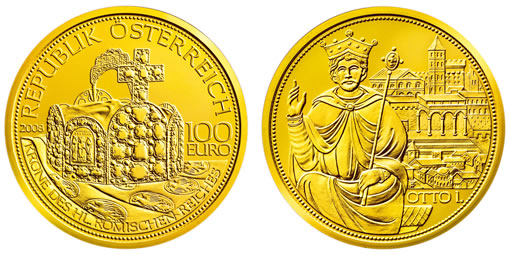On 5th November, 2008, the Austrian Mint in Vienna launched its new gold commemorative series “Crowns of the House of Habsburg.” The five coin series begins this year with the 1,000 year old crown of the Holy Roman Empire.

When the empire of the Caesars in the west sunk beneath the waves of barbarian invasions, it left a ghostly memory of unity and peace among the peoples of Europe and even among the rulers who had replaced it. On Christmas Day in the year 800 Pope Leo III, seeking a powerful protector from his enemies, crowned the Frankish king Charlemagne in St. Peter’s in Rome, thus reviving the imperial title that had vanished three centuries before.
Charlemagne’s empire, however, declined amidst the squabbles of his heirs, and it was not until the reign of Otto I (936-973) that a territorial empire comparable with that of Rome and Charlemagne existed once more. In 962 Pope John XII, also in search of a protector, crowned Otto I as emperor in Rome.
Most historians regard this coronation as the true birth of the Holy Roman Empire which was to continue until Francis II under pressure from Napoleon laid down the centuries old crown in 1806 and finally dissolved the ghost of the Roman Empire in Europe.
There is hardly a crown with such symbolic importance in the history of Europe than that of the Holy Roman Empire. Although it became largely an office of prestige with little actual power outside the territories of the emperor himself, the crown was a coveted prize for the powerful princes of Europe. Even Henry VIII of England tried to get himself elected to the venerable crown of Rome in 1519.
The crown was never actually hereditary, but by arranging the election of each successor in the lifetime of the emperor, the House of Habsburg ensured an almost unbroken possession of the dignity for three and a half centuries.
Today the crown is housed in the imperial treasury in the Vienna Hofburg. It consists of eight gold plates joined by hinges and encrusted with pearls and precious stones. Four of the panels have enamelled pictures of King David, King Solomon, the Prophet Isaiah and King Hezekiah, and lastly Christ enthroned between two angels with the inscription “per me reges regnant” (through me do kings rule).
The crown is usually attributed to Otto I in 962 and was probably the work of goldsmiths in the Rhineland. The frontal cross was added by Henry II, while the arch symbolising universal rule was an addition by Conrad II, whose name it also bears.
The new 100 Euro gold coin pictures the crown itself on the obverse side. The reverse shows a picture of Otto I based on a drawing from c. 1200. In the background is old St. Peter’s basilica in mediaeval Rome where Otto’s imperial coronation took place in 962.
The coin is struck in 986 fine gold and in proof quality only. The maximum mintage is 30,000 pieces world wide. The Austrian Mint has done everything in its power to reduce costs in order to keep the increase in price resulting from the present high gold prices as moderate as possible. Each coin comes in an attractive box with a numbered certificate of authenticity.
As an added attraction a pin with a replica of the crown is included with every coin. A prestigious collection case for the series may be purchased separately.
The series “Crowns of the House of Habsburg” will be continued next year with a coin for the crown of an Austrian Archduke.
# # #
Coin specifications for 100 euro, “Holy Roman Empire”crown commemorative
| Alloy: | Gold, Au 986 |
| Finish: | Proof |
| Diameter: | 30 mm |
| Fine Weight: | 16 g |
| Mintage: | 30,000 |
| Date of Issue: | 5 November 2008 |
| Face Value: | 100 euro |
| Designer: | Thomas Pesendorfer |
The coin may be ordered through the Austrian Mint website.
About the Austrian Mint
The Austrian Mint is situated in the heart of Vienna and is the official minting authority for Austria with a 800 year history.
The Mint is the source for all Austrian Euro and Cent coins, whether they are intended for shopping, as an investment or for collection. Before the Euro, the Schilling and Groschen coins were minted, and before that – during the monarchy – Crowns, Guilders and Ducats were struck by the Austrian Mint.
The company is located close to the centre at the Vienna Stadtpark in a Biedermeier building erected under Emperor Ferdinand I. from 1835 to 1837. Today it accommodates one of the most modern mints in the world.





